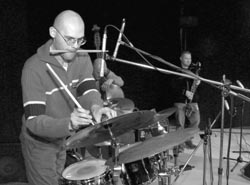Hands and Buttons New Sound festival at Contemporary Art Center

The middle of winter is ill-suited for staging any event in a festival format; it is hard to attract audiences who are saturated with the recent holiday festivities. The Contemporary Art Center, however, took the risk jointly with the Polish Institute, going about it in a manner strongly reminiscent of George Soros. They came up with a “festival-laboratory of music performances and sound installations” and titled the project “New Sound.”
Do not be misled by this fashionable terminology. “Perfomances” and “installations” — i.e., sophisticated spectacles, creative gestures, meant to illustrate certain ideas, confirm or reject some lingual discourse, did not happen at the CAC. The “new humanitarian language” turned out to indicate an ordinary kind of entertainment, a krikh, meaning a party. Except that CAC was used in lieu of a club because its interior is very special, far superior to that of any nightclub, and the show had to end at an early 9 p.m. The rest was a well-known scenario: a milling crowd of guests, a dissipated bohemian atmosphere, voices of admiration in one corner, and chain-smoking in the other... People came not to watch a “performance” but to explore a traditional cultural product. The first evening was dedicated to a video composition complimented by disc jockeys. What the Georgian producer Georgy Dzhodzhuashvili, known as a theatrical composer at home, showed was something other than a computerized discotheque experiment. Rather, it was stage music, moderately fancy, with various stage effects. The audience, mostly students, would probably have preferred DJ Derblaster and Margarita Zinets, with flashing colorful signs to a noisy electronic accompaniment. The main visual attraction was a mini video film with the Swiss group COM&COM, made five years ago by Johaness M. Hedinger and Marcus Gossolt. The two acidly witty video artists built their opuses on absurd Hollywood blockbuster clichйs. The title of the project was C-Files: Tell Saga. Johannes and Marcus told their saga in the form of ads and scenes from something zealous, gothic or mystical, that reminded of a spy story. A scene from the burlesque C-Files had been previously demonstrated at CAC. This time it was Episode №03 about aliens, of course. The setting in a dark forest with mystic lighting, a man and a woman, lost and confused, and then several minutes of the pure joy of a snow- white humanoid frolicking against a vast Alpine landscape with mountains and lakes. The sight was really out of this world with Derblaster’s sound effects thundering throughout the interior.
The second evening turned out to be manifestly retrospective, with polyphonic songs and Polish jazz. The Music Assemblies was the first to perform. It was a young group displaying authentic vocal skill. But the audience, eagerly anticipating the jazz numbers, unfortunately ignored Denys Piddiachy, Zhanna Honcharenko, Olha Havrylova, Tetiana Sykhyna, and Maksym Yefimchuk. Meanwhile, they had prepared an exquisite program of 17th-18th cc. baroque music, including rare Mykola Dyletsky’s polyphonic motets (restored by the excellent music historian Nina Gerasimova-Persidskaya), religious chants by Feofan Prokopovych, Yepifany Slavinetsky, Dmytro Rostovsky; early opuses by Claudio Monteverdi, Henry Purcell, and Thomas Morley. This kind of singing is sometimes melancholic, other times solemn, but always divinely pure and fascinating and it sounded the most relevant on the CAC premises, which was built in the 17th century and meant as the brotherhood school of the Kyiv-Mohyla Academy.
The Oles-Trzaska-Oles Polish jazz trio proved the greatest attraction (quite interesting, considering that serious jazz had never been practiced in Kyiv). The charming Polish trio had captivated the capital’s motley audience the previous week, in a show jointly with Yuri Andrukhovych, Serhiy Zhadan, and Andriy Bondar. As it was the free jazzmen Mikolaj Trzaska (sax, clarinet), Marcin Oles (double bass) and Bartlomiej Brat Oles (drums) proved their worth, showing they could handle any kind of improvisation. Their performance was relaxed, witty, with a theatrical touch, marked by genuine European finesse. The audience appreciated all this and showed their admiration. The concert was broadcast throughout CAC (albeit with occasional audio equipment breakdowns) and this must have been the installation’s idea.
Strange as it may seem, this approach of mixed genre appears most effective for CAC actions, and not only in the purely festival format. However aptly conceived and well arranged, projects by domestic and foreign media artists mean little unless complimented by an unpredictable live element, human voice, and instrumental skill.
Anyway, the New Sound seems to be aimed in the right direction. The coming Spring Festival will star performers whose very names make every music lover bow respectfully: Arkady Shilkloper and Volodymyr Cherkasin.






